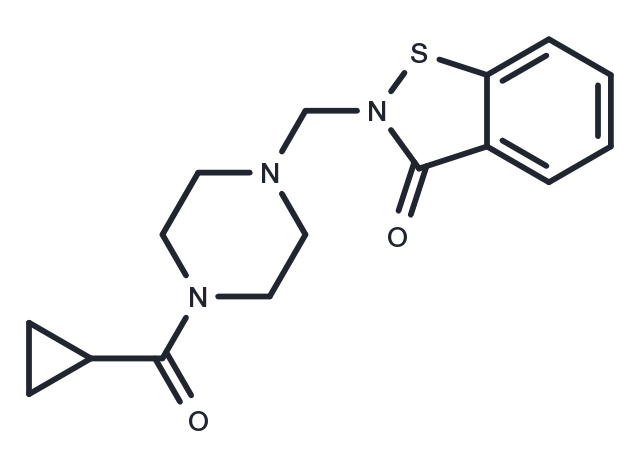Powder: -20°C for 3 years | In solvent: -80°C for 1 year


LOC14 to be the most potent PDI inhibitor reported to date( EC50 : 500 nM)

| Pack Size | Availability | Price/USD | Quantity |
|---|---|---|---|
| 5 mg | In stock | $ 43.00 | |
| 10 mg | In stock | $ 81.00 | |
| 25 mg | In stock | $ 171.00 | |
| 50 mg | In stock | $ 310.00 | |
| 100 mg | In stock | $ 543.00 |


| Description | LOC14 to be the most potent PDI inhibitor reported to date( EC50 : 500 nM) |
| Targets&IC50 | PDI:500 nM(EC50) |
| In vitro | LOC14-induced oxidation of PDI has a neuroprotective effect not only in cell culture, but also in corticostriatal brain slice cultures[1]. |
| In vivo | LOC14 showed high stability in liver microsomes and blood plasma, was tolerated at a high dose of 20 mg/kg in mice, and penetrated the BBB in vivo[1][2]. |
| Animal Research | LOC14 levels were measured in mouse plasma, striatum and cerebral cortex using Ultra Performance Liquid Chromatography-Tandem Mass Spectrometry (LC-MS/MS).?LOC14 was extracted from mouse plasma by mixing 100 μl of plasma with 900 μl of cold acetonitrile containing 25 ng/ml of cyclocreatine as an internal standard.?After mixing for 5 min. the sample was centrifuged for 10min and the organic layer was transferred to an LC-MS vial and dried under nitrogen.?The sample was reconstituted in 100 μl of 50% acetonitrile and 5 μl was injected onto the LC-MS.?Brain tissue samples were homogenized using a tissue tearor at a concentration of 150 mg/ml in cold LC-MS water followed by extraction with 1.8 ml of cold acetonitrile containing the cyclocreatine internal standard.?The brain samples were mixed and centrifuged and reconstituted the same as for the plasma samples[2]. |
| Molecular Weight | 317.41 |
| Formula | C16H19N3O2S |
| CAS No. | 877963-94-5 |
Powder: -20°C for 3 years | In solvent: -80°C for 1 year
DMSO: 25 mg/mL (78.76 mM)
You can also refer to dose conversion for different animals. More
bottom
Please see Inhibitor Handling Instructions for more frequently ask questions. Topics include: how to prepare stock solutions, how to store products, and cautions on cell-based assays & animal experiments, etc.
LOC14 877963-94-5 Others LOC-14 inhibit LOC 14 Inhibitor inhibitor
